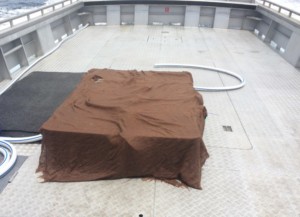Privacy Notice
This website uses cookies to improve your experience. Read our Privacy Policy to learn more.
Over the next few weeks, a perfect storm of big catches, extreme hot weather and strong winds will combine to make it one of the most critical times for determining the ultimate success of your season. Everything needs to be working perfectly to minimise any damage and losses – from the deckie’s handling of lobsters during sorting, to the live tank water and air supplies and effective draining procedures. With less than a week before Opening Day, some careful preparation now can save you a lot of angst and money over the next month or two!
Exposure to hot dry windy conditions not only has a direct effect on your lobsters (by heating them up), but also causes dramatic leg loss through increased evaporation and concentration of salt on every surface. Avoid problems associated with this hyper-salinity by making sure deckies regularly use seawater to wash down gloves, cakka boxes and anything else that is likely to contact lobsters.
The cakka box is the first open air environment lobsters experience. Tumbling out of the pot onto a hot, dry, hard, salty surface is far from ideal. Consider lining your cakka box with padding and adding seawater sprays to keep the lobsters and cakka box wet. These simple changes have a dramatic effect on maintain lobster quality.
Like everything else, there are good and bad ways to drain lobsters. Minimise draining times, especially when it’s hot. Draining lobsters below deck is by far the best method for protecting them from the elements, but you can only do this if you can aerate the water in the tanks once you turn the pumps off. If you do choose to drain your lobsters on deck, do your best to protect them from the sun, heat and wind. GFC Research has shown that covering your catch with wet hessian increases humidity and decreases the temperatures your lobsters are exposed to by up to 3⁰C. This ‘Coolgardie safe’ will also protect your lobsters from wind and direct sunlight and the increased humidity decreases effects of hyper-salinity due to drying out. Your deckies have an important role to play here. Baskets shouldn’t be drained over hot engine hatches and the hessian must be kept wet to maintain the cooling effect. Hessian is available to all GFC Fishermen for FREE from the GFC Store. Refer to below advert to arrange delivery to your local depot.

Water pumps: Constant flow pumps are really the only way of ensuring enough fresh seawater is getting to lobsters in your day and live tanks. To calculate the size of water pumps necessary, a good rule of thumb is 1 litre of water / kg of lobster / minute. For example, a live tank that holds 30 prawn crates (each holding 27 kg of lobsters) will need to be supplied 30 x 27 = 810 litres of seawater per minute.
If you need to upgrade or replace your water pumps, the GFC Marine Store has a special on at the moment (see last page of this Catcher edition).
Water intake and distribution: Check that seawater intake strainers are clean and in good working order. Likewise, ensure hoses and pipe work from intakes to pumps and from pumps to tanks are free of debris, marine growth, kinks and cracks, etc. Replace hoses (and hose clamps) if you are in doubt. A small investment in hoses and hose clamps now can you save you a lot of heartache (and money) if your water supply fails when your tanks are full of lobster.
Air Supply: Check that all air hoses are in good condition. Replace diffuser hoses as these become blocked over time. The GFC Marine Store stocks our recommended air hose.
Remember:
And finally, if a lobster drops on the deck, it will have internal damage: throw it back!
If you would like any assistance with lobster handling and drain conditions, contact GFC Continuous Improvement Manager, Brad Armstrong (0437 513 837) or GFC Research and Development Officer, Joel Durell (0407 135 712).